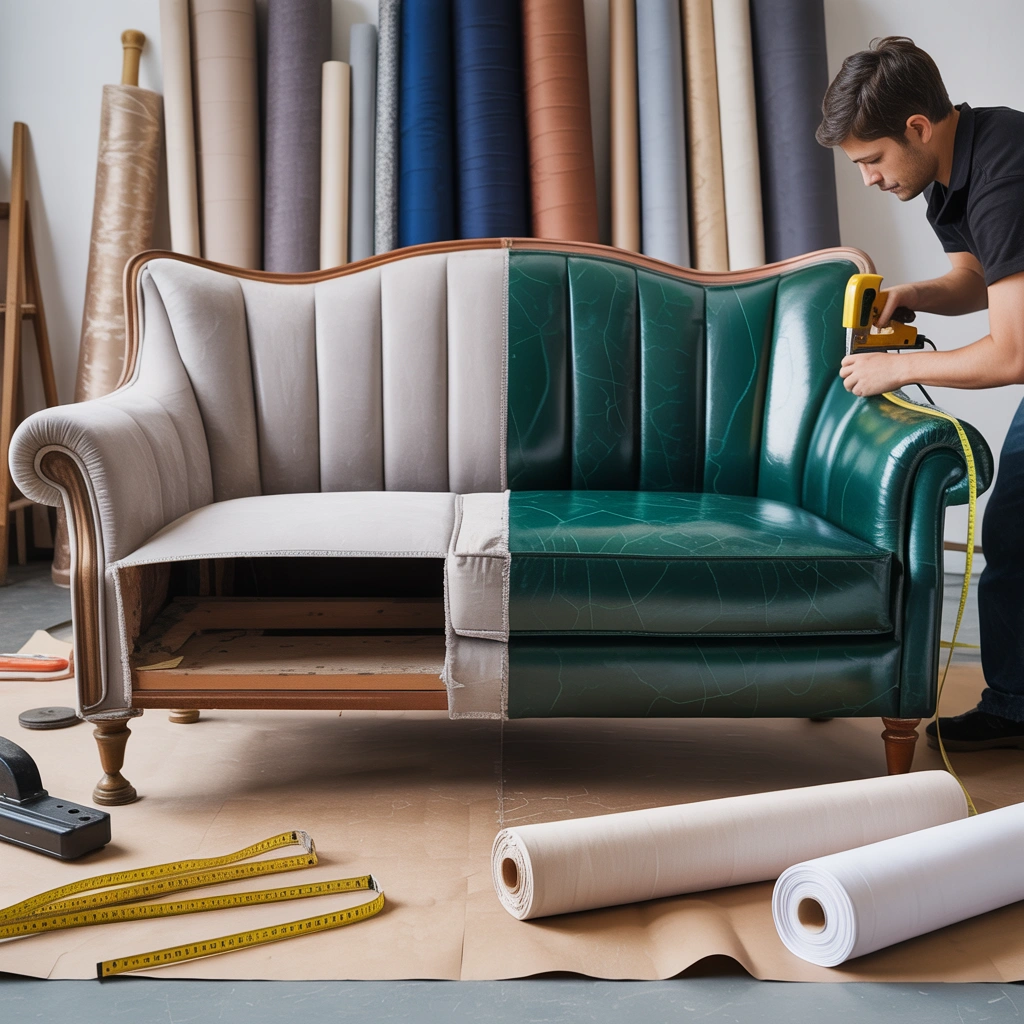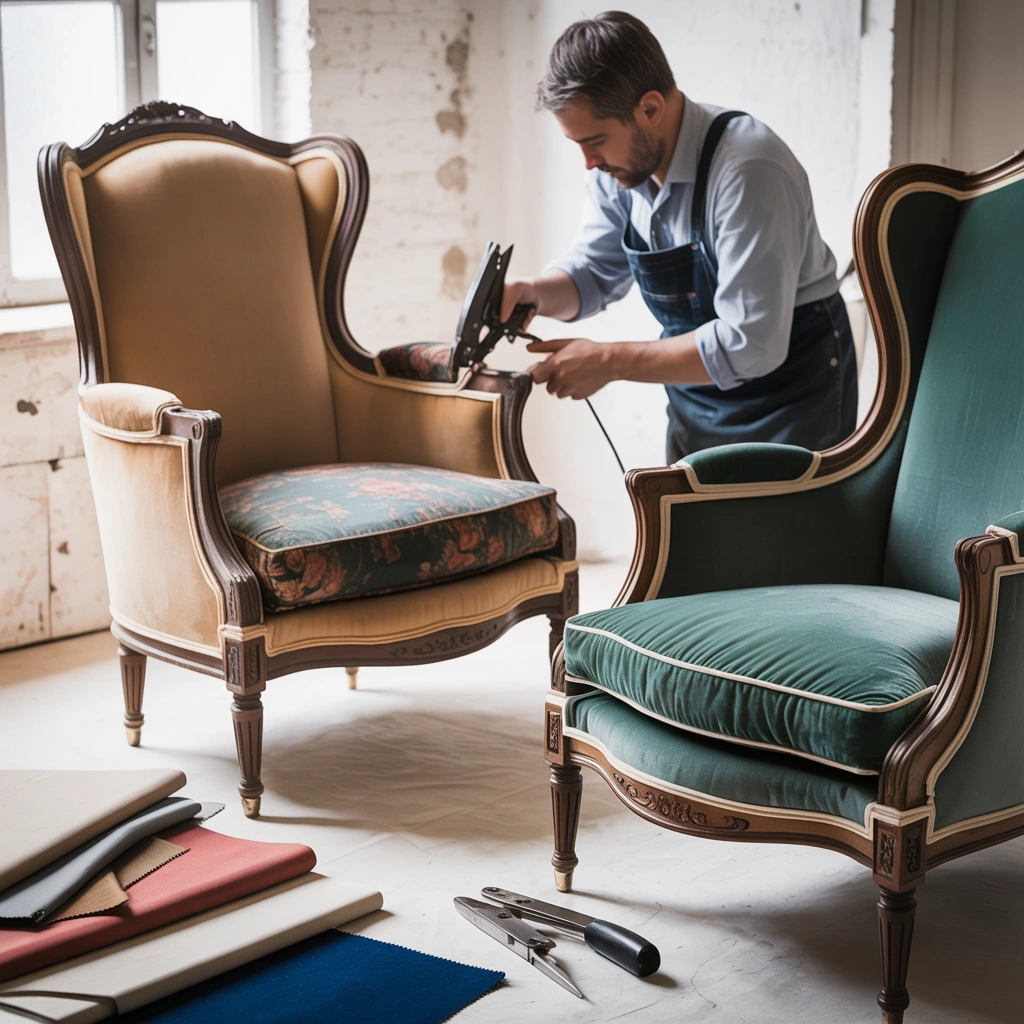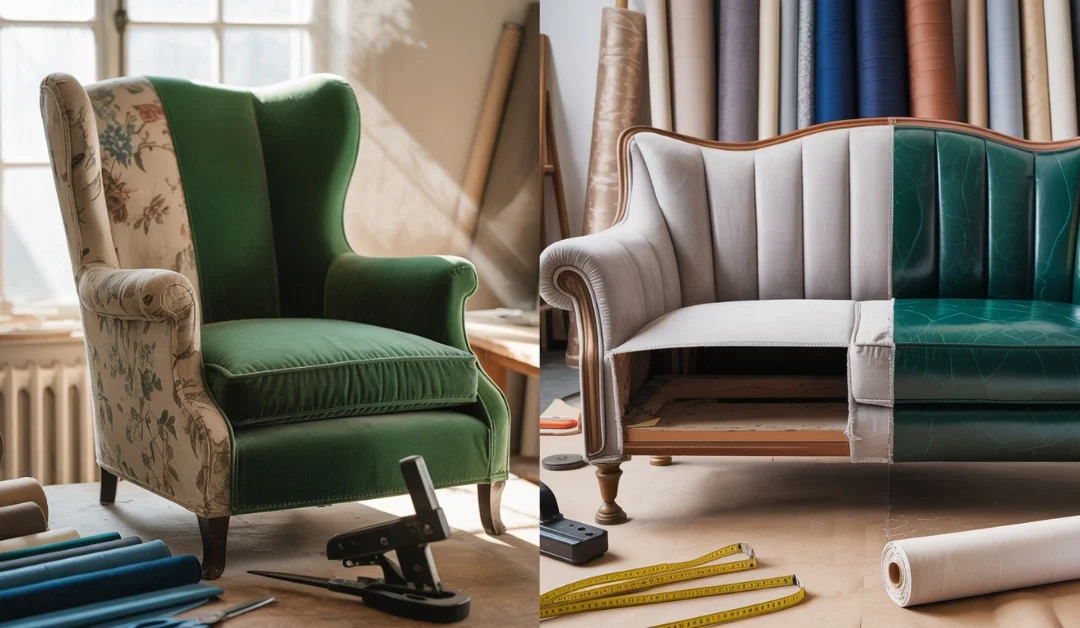Old furniture is often thrown away when it still has life left in it. By reupholstering, time and money can be saved. A fresh look for your home can be created without spending a lot.
Reupholstering is not just about fixing up old chairs or sofas. It is a way to reduce waste and give something new to something old. For example, a worn-out armchair might be turned into a stylish piece that matches your room’s design. This process is often cheaper than buying new furniture.
If you want to learn how to match your new upholstery with your home’s style, check out this guide on curtain color combinations for every room.
1. What Is Reupholstering?

Reupholstering is the process where old fabric is removed and replaced with new material. It is different from refinishing, which focuses only on the wood or frame.
No professional skills are needed. With simple tools, anyone can try. The steps are easy to follow, even for beginners.
For Example:
- Old fabric is pulled off carefully.
- New fabric is cut to fit the furniture.
- The new fabric is attached using staples, glue, or sewing.
If you’re curious about how furniture styles can change a room, read about Arabic majlis vs. modern sofas.
Tools and Materials Needed
To begin, the following items are commonly used:
- Staple Gun – Used to attach fabric to the frame.
- Scissors – Needed for cutting fabric and foam.
- Measuring Tape – Helps find how much fabric is required.
- New Fabric – The main material for covering the furniture.
- Foam or Padding – Added for comfort if cushions are worn.
Optional tools include pliers (for removing old staples) and a sewing machine (for attaching fabric without glue).
If you’re unsure which tools to buy, learn how to pick the best carpet tiles vs. wood flooring for ideas on where to shop. You may also want to check out our Sofa Size and Layout Guide for Comfortable Living Spaces to make sure everything fits just right.
2. How to Choose the Right Upholstery Fabric
Picking the right fabric is important. Durable options like microfiber or linen are great for sofas. Here’s how to choose:
Popular Fabric Types
- Microfiber – Soft and stain-resistant. Good for families with kids or pets.
- Linen – Breathable and stylish, but may wrinkle easily.
- Velvet – Luxurious but requires careful cleaning.
- Cotton – Affordable but less durable over time.
How to Pick Durable and Stylish Options
- Touch Test: Rub the fabric between your fingers. If it feels strong and thick, it’s a good choice.
- Color Match: Use a swatch to see how the fabric looks in your room’s lighting.
- Pattern: Bold patterns hide stains better than plain colors.
How Much Fabric Do You Need?
Measure the furniture before buying. A rough estimate is:
- Chair: 2–3 yards
- Sofa: 7–10 yards
For more ideas on matching fabric with your home’s style, explore curtain color combinations.
3. Step-by-Step Guide to Reupholstering
This section will walk you through reupholstering a sofa or chair, step by step.
Step 1: Remove Old Fabric
The old fabric is pulled off carefully to avoid damaging the frame. Staples or nails are taken out using pliers.
Tip: Take photos of how the old fabric was attached. This helps when putting the new fabric in place.
Step 2: Inspect the Frame
Cracks or loose parts are fixed before new fabric is added. If cushions are flat, new foam is cut to size.
Step 3: Measure and Cut New Fabric
The new fabric is laid over the furniture, and extra space (about 4 inches) is left around the edges.
Tip: Use a marker to draw lines on the fabric for easier cutting.
Step 4: Attach the Fabric
A staple gun is used to secure the fabric tightly. For no-sew options, strong glue is applied to hold the material in place.
Tip: Start in the center and work outward for a smooth finish.
Step 5: Add Final Touches
Buttons, trim, or covers are reattached to match the original design.
For a visual guide, see Arabic majlis vs. modern sofas to learn how small changes can transform furniture.
4. Tips for Reupholstering Without Sewing

Yes! Fabric can be glued to the frame instead of stitched. Here’s how:
Best No-Sew Methods
- Strong Glue: Apply adhesive to the frame and press the fabric in place.
- Double-Sided Tape: Works well for small projects like chairs.
- Staples: A staple gun can hold fabric without sewing.
Can Glue Replace Stitching?
Glue is good for light use but may not last as long as sewing. For heavy-use areas, a mix of glue and staples is best.
5. How Can Reupholstering Change Your Home?
Old furniture can be matched to new decor styles. For example:
- A modern sofa can be updated with bold colors.
- A vintage chair can be refreshed with neutral tones.
To see how design choices affect a room, read about Arabic majlis vs. modern sofas.
Final Tips for First-Time DIYers
Start small! Try reupholstering one chair first. Confidence will grow as each step is completed.
Safety Tips :
- Wear gloves when handling sharp tools.
- Work in a well-lit area to avoid mistakes.
6. Common Questions About Reupholstering
It is not recommended because it may tear or look worn.
A chair can be done in 2–3 hours. Sofas may take a full day.
Yes! Costs are often 50–70% less than purchasing a new piece.
High-density foam is best for cushions. It lasts longer and stays comfortable.
A regular machine can work for light fabrics, but heavy-duty models handle thick materials better.

